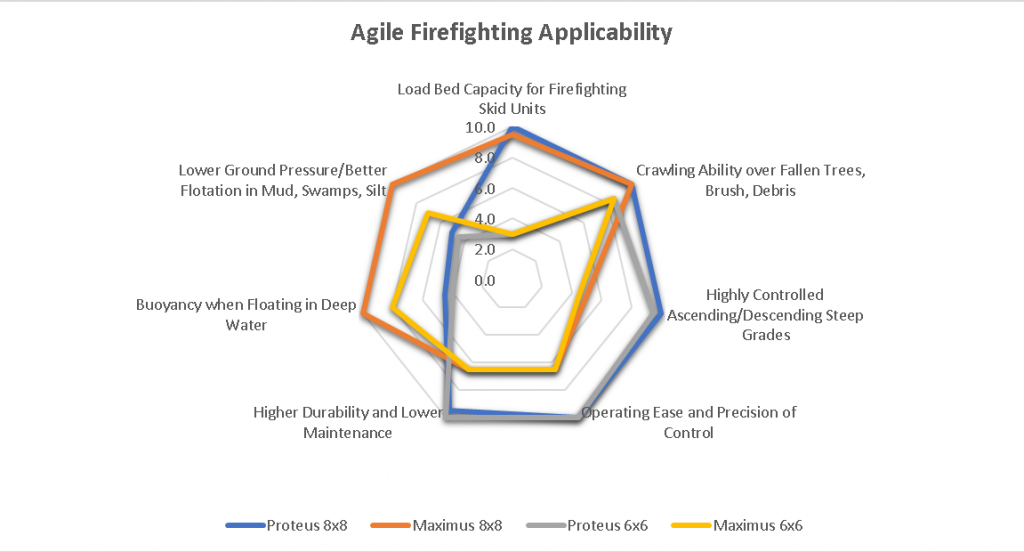Firefighting – Wildfires
Wildfire: “Any unplanned and uncontrolled wildland fire that, regardless of ignition source, may require suppression response or other action according to agency policy.” United Nations FAO

The incidence and severity of wildfires has had devastating effect in some regions during 2019 and 2020. Dealing with them is always a challenge, remoteness and inaccessibility making management and suppression difficult and expensive, or in many cases impossible. The costs can be immense; for instance the US Forest Service expends $1.2Bn per year in wildfire suppression activities, the majority of which ($1Bn) is expended on the 2% of fires that escape suppression and become large.
Effective early engagement is key and, if effectively used our extreme terrain vehicles can play a critical role as part of the armoury of any wildland firefighting department, partnership or Fire Group – whether directly through application of water to burning fuel, or indirectly by transporting a crew of up to six with pioneer tools, drip-torches and powered agricultural brush cutting ancillaries to create control-lines or firebreaks.
High Pressure-Low Flow. Brush and wildfires are traditionally dealt with using low flow rates at high pressures, typically in the range 14-75 L/min at 14-25 Bar pressure. The low flow rate allows most efficient use of water, which is usually a strictly limited resource, and the high pressure allows the flow to be dispersed into smaller droplets, which are more efficient in absorbing heat, transitioning to steam and thereby smothering the fire by denying oxygen. A mix of larger droplets assists in maintaining flow of smaller droplets through turbulent air and wetting the fuel source. This pump technology will generally use multi-stage impellors which have the advantage of simplicity, robustness and good tolerance of debris..
We can offer a range of high quality systems that operate in this range, the optimal solution of which is likely to be influenced by familiarity with equipment, adaptor standards (which typically differ between regions) and local spares availability – as well as the pure technical performance characteristics, cost and reliability. The logistics, training and support implications are an important factor that we will always take into account when advising on an optimal solution.
Ultra-High Pressure (UHP) Systems. UHP systems have established an important foothold in wildfire work, operating typically in the 75-1200 Bar pressure range but at reduced flow rates of 20-40 L/min. The higher pressure allows for much smaller droplet sizes, typically in the ‘sweet spot’ 50-300 micro-meter size, with larger surface areas improving heat absorption and steam generation.
But achieving these pressures efficiently requires different, higher precision pump technologies with some implications in terms of cost and the cleanliness of the water source required. A clear benefit however, is the reduced rate of water consumption, which can greatly extend the operating time from a limited volume of water.
Specialist Nozzles. Further improvements in droplet management and sizing can usually be achieved by selection of appropriate nozzles that achieve smaller droplet sizes by innovative use of jet, swirl and collision technologies.
Foam. The use of foaming agents will further reduce the necessary water for a given suppression effect. Foaming option are available on all devices.
Underlying all of this is the ability to get the vehicle, along with water and equipment to the right place in a safe and timely manner. Agility, low CofG and high load capacity are key to achieving this. As a quick visual aid to assist you with narrowing in on the right Agile vehicle model for your Fire Management operation, please refer to this chart which ranks the relative standings of key attributes of a suitable Agile vehicle in your setting:

Note various relevant attributes are ranked on a scale of zero to 10, with 10 being the highest performance score. Each different Agile vehicle model is then depicted on the graph as a polygon shape, with the overall size/area of the polygon indicating the overall applicability of that vehicle to this role relative to the others. Then if certain attributes are more important to you than others, you can view how the vehicle ranks on that attribute by seeing how close it comes to the outer “level 10” line where that attribute is labelled on the graph.
[display-posts posts_per_page=”100″ category=”r-firefighting”]

